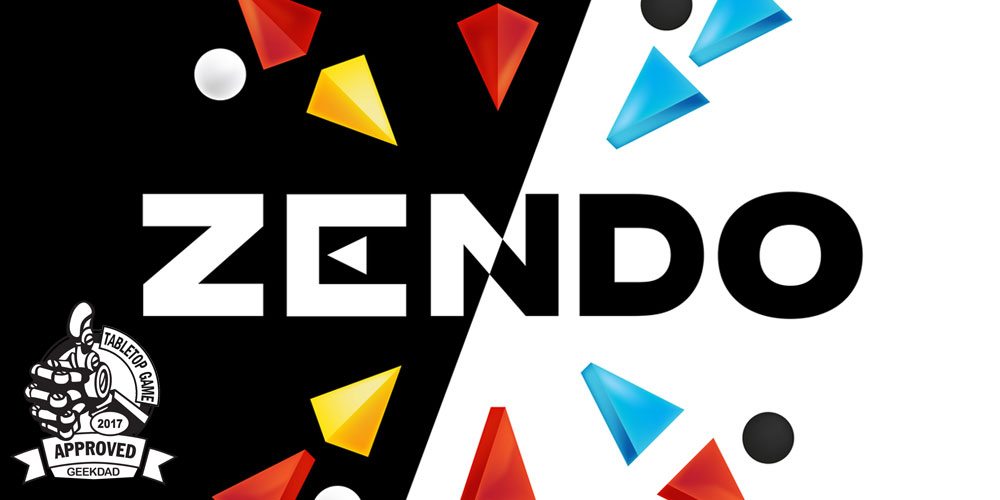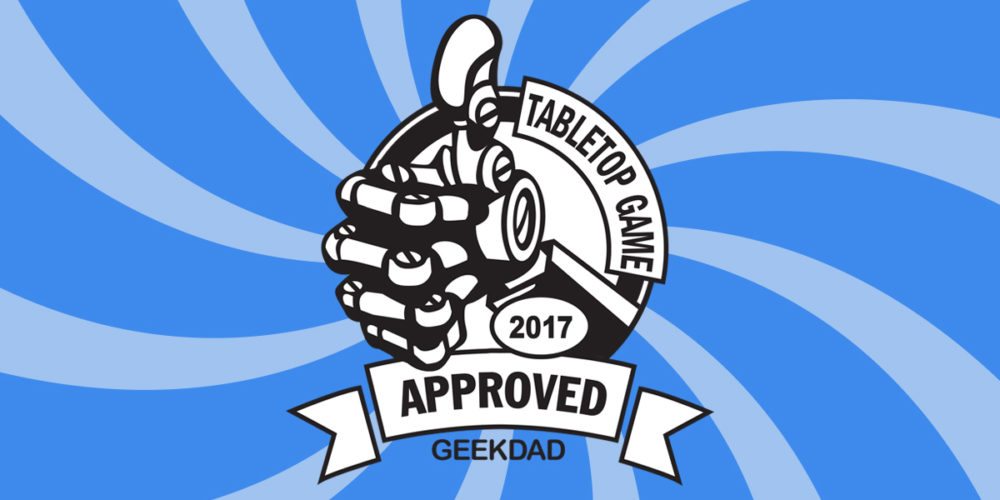Zendo has been around for a while: it was one of the games you could play with Looney Pyramids back when they were called Icehouse Pyramids. Now it’s back, with some awesome new components.
What Is Zendo?
Zendo is a logic-based game for 2 to 6 players, ages 12 and up, and takes 15–60 minutes to play. It’s available for preorder now from Looney Labs or Amazon for $40, and is expected to ship in late November. There’s nothing inappropriate for younger kids (as long as they’re old enough not to swallow small bits) but the inductive reasoning may be a little tricky for kids under 12.
Zendo is GeekDad Approved!

Zendo Components
- 27 Pyramids (9 per color)
- 27 Wedges (9 per color)
- 27 Blocks (9 per color)
- 27 black disks
- 27 white disks
- 27 green cubes
- 40 Rules cards
- 2 clips
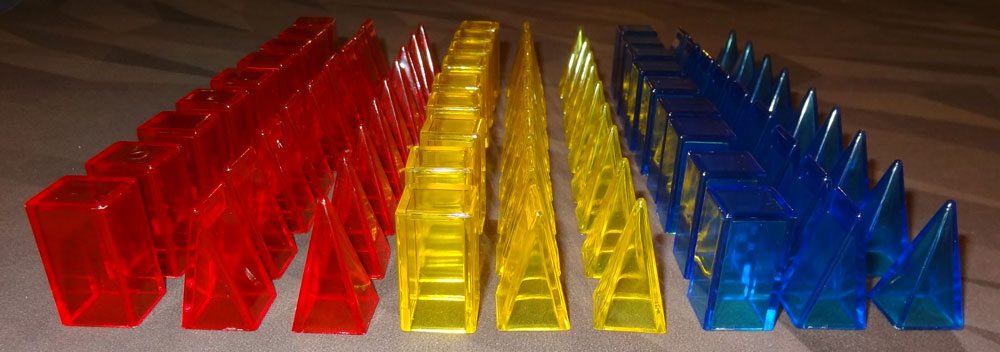
The pyramids are almost identical to the largest size of Looney Pyramids (as seen in the Pyramid Arcade): translucent plastic, four-sided, and without a base so that they can be nested. The only difference is that they don’t have the pips on the side that mark the three different sizes of Looney Pyramids—in Zendo, there is only the one size. The wedges and blocks, new to this edition, are similarly constructed: they have the same height and same open square base as the pyramids. Wedges are triangular prisms, and blocks are rectangular prisms. The pieces come in red, blue, and yellow.
The disks and cubes are all small bakelite pieces, and they have a nice feel to them. The two clips are those basic triangular plastic paperclips. The box is pretty bare-bones: just a large box with baggies for the components, and no insert.

The rules cards are also new to this version of Zendo and help the moderator create rules for the other players to guess. The cards are marked with a difficulty level. Many of the cards have one or two choices that you can make about the rule, which you mark with the clips—cards that do not have two choices will have decoy spaces so you can mark them, so other players don’t know which card you have. The clips can leave a bit of a bend in the cards, which is unfortunate. I think for the decoy cards, you’d want to have a few decoy spaces so that people can’t tell that the decoy clips are always in the same places on those cards.
How to Play Zendo
You can download both the Getting Started rules and the Going Deeper booklet as PDFs.
The Goal
One player serves as a neutral moderator and provides answers about a secret rule—the goal of the game is to be first to figure out the rule.
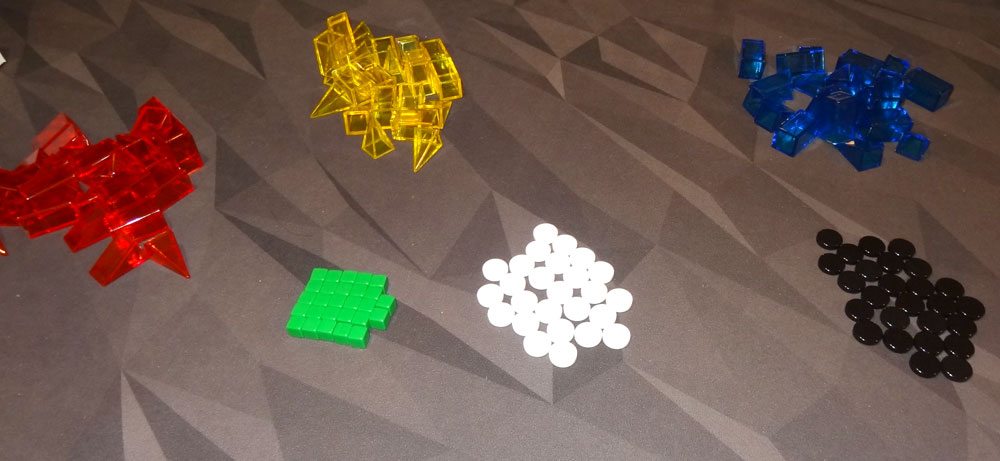
Setup
Set out all of the pieces. Choose a player to be the moderator, and give everyone else one black disk and one white disk. The moderator chooses a rule card and marks it with the two clips, setting the rule that everyone else will try to guess. The moderator builds two structures, one that follows the rule and one that does not, and then marks them with the black and white disks, white if it follows the rule and black if not.
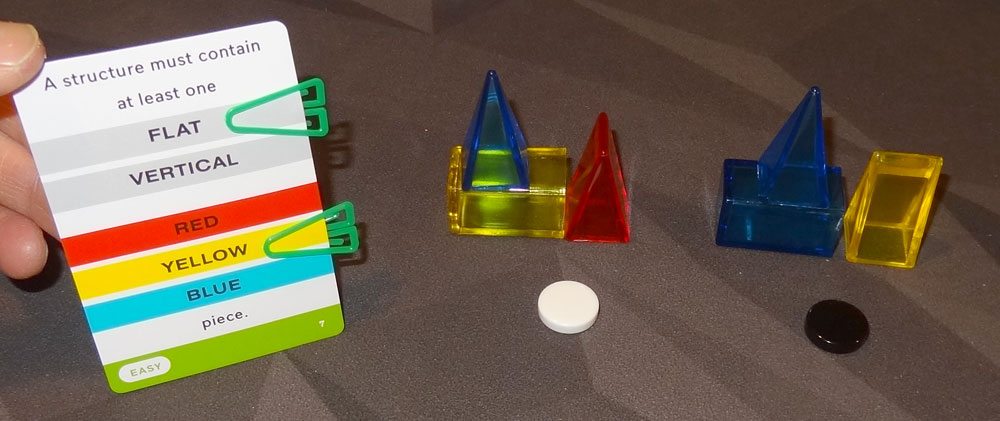
Gameplay
In turn order, players take turns building their own structures to try to figure out the rule. After building a structure, the player chooses “tell” or “quiz.” “Tell” means the moderator looks at the structure and marks it with a token to indicate whether it follows the rule. “Quiz” means all players get a chance to guess whether it follows the rule or not. Everyone uses their disks to secretly vote, and then reveals. The moderator then marks the structure with a black or white disk. Players who were correct get a guessing token (green cube).

Finally, you may optionally make a guess: pay one guessing token to the moderator and then state your guess as clearly as possible. The moderator may need to clarify your guess in case it’s ambiguous. Once you and the moderator have both agreed on what your guess is, then the moderator will try to disprove your guess. (If a structure on the board already disproves your rule, the moderator points that out and you don’t spend a guessing token.)
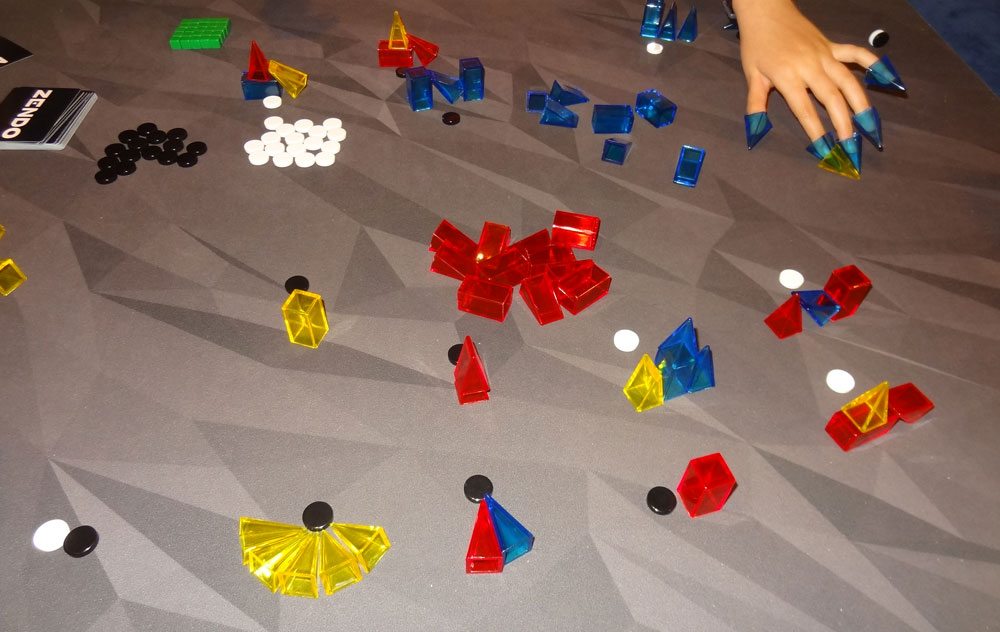
To disprove a guess, the moderator must either build a structure that follows your guess but doesn’t follow the rule, or one that doesn’t follow your guess but does follow the rule, marking it with the appropriate disk. You may spend as many tokens on guessing on your turn as you wish.
Game End
The game ends when the moderator is unable to disprove your guess–you win!
Terminology and Rules
There are a lot of terms that Zendo uses to formalize how things are positioned in relationship to each other and to the table. Generally you don’t have to teach the players all of them until they come up in play, but they’re all defined in the Going Deeper booklet. Rules may include details about types of pieces (pyramids, wedges, blocks), number of pieces, and colors, of course.
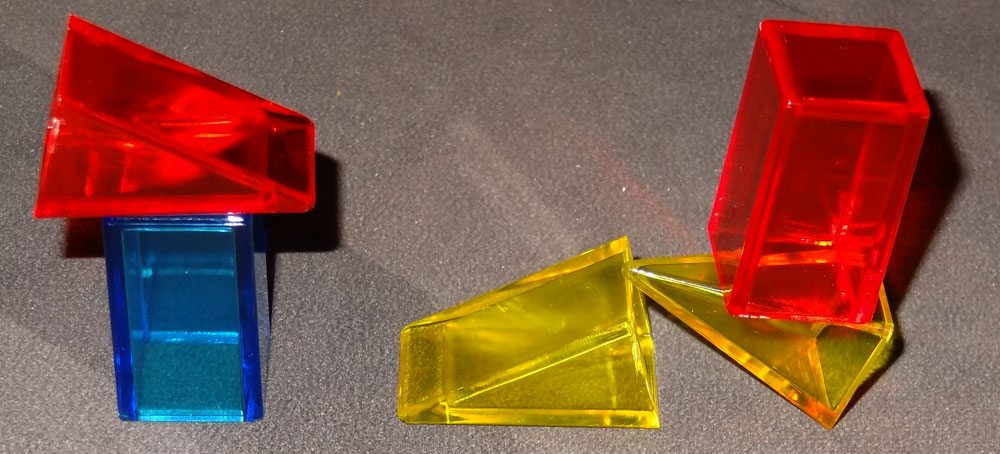
Grounded means that some part of the piece is touching the playing surface; ungrounded means it is completely off the playing surface.
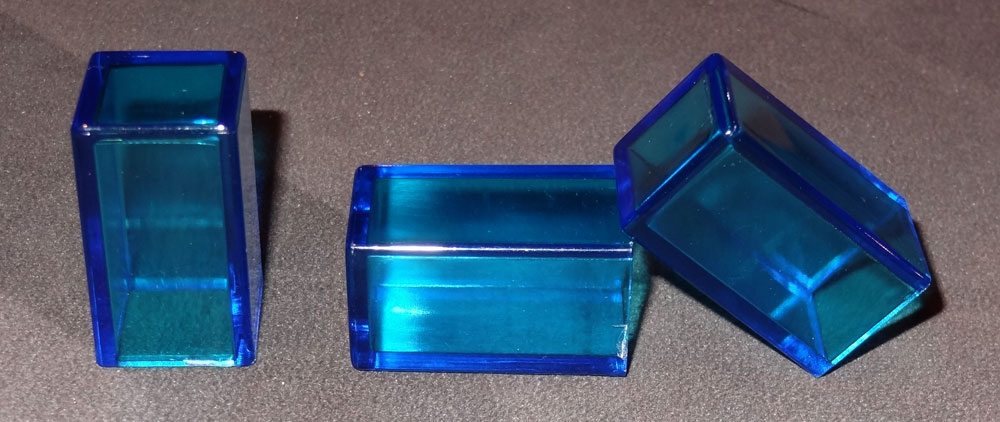
Pieces may be vertical, flat, or “weird” (neither vertical nor flat). If vertical, they can be upright (base down) or upside-down.

Wedges that are flat have two possible orientations, called “doorstop” and “cheesecake.” Shapes can also “point” through their tops: a pyramid points in a line, a wedge points in a ribbon, and a block points in a square beam.

Pyramids may be “nested” inside any type of piece. Also, if any portion of a piece extends into the base of another, it is considered “inside” (but not necessarily nested).
Two-Player Variants
With only two players, you will need one player to be a moderator, so it is essentially solitaire. However, you can play twice, taking turns being the moderator. When somebody guesses a rule, count up the total number of structures that have been built. Whoever guesses the rule in the fewest number of structures wins. (In a 2-player game, you do not need to use guess tokens.)
Why You Should Play Zendo
Zendo is based on an older inductive logic game called Eleusis, as designer Kory Heath details on his website here. It has had different themes applied to it: when I first learned it years ago, it used the theme of a Zen master training pupils (thus the name), but the theme isn’t necessary to enjoy the game, and this latest version does away with the theme and lets the logic puzzle stand on its own. That seems to fit well, really, because the game is about specific, concrete rules and geometric shapes, and it doesn’t need a somewhat mystical theme applied to it.

The older version of Zendo had just 16 rule cards; the new version has 40 cards, most of which have multiple options, making it possible to create a vast number of rules. While you can still come up with your own rules (like the very earliest versions of the game), the rulebook recommends using the cards first until everyone is familiar with the game, because it can often be tricky to judge the difficulty of a rule you created. Sometimes a rule seems totally obvious to the moderator, but can still take quite a bit of experimentation for the players to figure out. The rule cards make it a lot easier to create rules within a particular difficulty range.
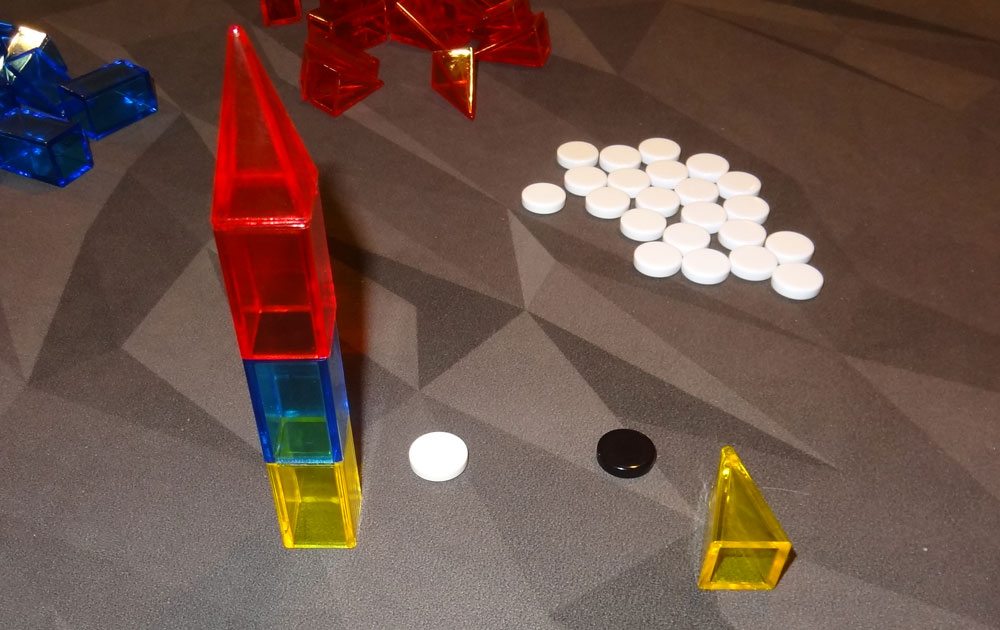
What I love about Zendo is that it turns inductive reasoning into a game. You make observations, try your own experiments to see the results, and eventually figure out the underlying rule–it’s like experiencing the scientific method. The reasoning can be a little tricky for younger kids, but I do think it can still be a great way to get them thinking about and practicing logic. My 11-year-old liked the concept but preferred to be the moderator because she found the guessing a little hard–I’m hoping through continued play she can start to recognize the patterns and figure out how to uncover the rules.
I also like the way that players earn guessing tokens by evaluating a structure–you not only make hypotheses about your own structures, but if you think you’ve figured out the rule, you get a chance to test it on something somebody else built.
The moderator role generally will be a little less interesting to most players–you don’t really feel like you’re playing the game so much as observing the others and just confirming or denying the structures other people have created. There is still a little bit of logic practice for them, too, in trying to figure out how to build a structure that disproves an incorrect guess, but that may be a smaller part of the game depending on how often other players make guesses.
The new pieces are fantastic, and allow for a lot of cool structures (along with all those new rules). There are no longer different sizes of pyramids and only three colors, but you really don’t have to worry that it limits the types of rules you can create. I suppose if your group gets really good at guessing rules, you could always throw in the Pyramid Arcade set and use multiple pyramid sizes and even more colors, but that increases the complexity significantly, so I wouldn’t recommend it for novices.
As I mentioned in my review of Pyramid Arcade, I’ve been a fan of the Looney Labs pyramids for a long time now, and I love the way that they encourage creative thinking. This new edition of Zendo is a great update and I hope it introduces a new generation to another excellent game. And, although it doesn’t say anything about it in the rulebooks, these new shapes might even allow you to create some other new games, too, either alone or combined with Pyramid Arcade.
If you enjoy logic puzzles, I highly recommend Zendo. If you need some more theme or you like a bit of random chance in your games, it’s probably not for you. I’ve given it the GeekDad Approved seal because I think it’s a game that geeky would appreciate: it develops critical thinking skills and is a fun way to explore logic.
Click here to see all our tabletop game reviews.
If you’d like to stay up-to-date with all of our tabletop gaming coverage, please copy this link and add it to your RSS reader.
Disclosure: GeekDad received a copy of this game for review purposes.
